4 Types of agile meetings and what’s on their agendas
In this article, we review some basics about the Agile method, the Agile meetings you need on your calendar and agenda templates to run them.
Warning: Undefined array key "category" in /www/hypercontext_216/public/wp-content/themes/Soapbox/hype-files/sections/article/content.php on line 10
Operating under the Agile methodology is second nature to many software developers. In fact, given the success it’s had over the last 20 years in supporting fast-paced, high-performing teams, it’s now also gained popularity across other functions.
In this article, we’ll take a closer look at the core 4 Agile Scrum meetings and answer the following questions:
- What’s Agile Methodology?
- What are Agile meetings?
- How do you run an Agile meeting virtually?
- What are the 4 Agile meetings? (+ agenda templates!)
Let’s get started!
What’s Agile Methodology?
The Agile framework is more of a philosophy than an actual method. The approach was founded in 2000 by a group of software developers and centres around 4 main values:
- Individuals and interactions over processes and tools
- Working software over comprehensive documentation
- Customer collaboration over contract negotiation
- Responding to change over following a plan
Under the Agile umbrella, you can find many more specific methods that aim to foster the values listed above, including the infamous Scrum framework (which we use at Hypercontext!).
Because of the constant collaboration and iteration required for Agile, work is broken down into short timeframes, known as sprints, that range between 1-4 weeks.
Agile vs. Waterfall
You may have also heard of Waterfall methodology — an alternative to Agile that’s commonly used. In case you’re trying to decide which is best for your team, here’s a quick review of the differences between the two before we dive further into Agile.
Agile is conducive to iteration throughout a project, while Waterfall is a more linear approach.
What does this mean?
Waterfall uses sequential phases that rely on a plan. You can’t move to the next phase without first completing the one before it. This method is process-driven and less favorable to change in the middle of a project. Whereas Agile emphasizes continuous collaboration and evaluation every few weeks, Waterfall sets the scope of work and deadlines at the beginning of the project and sticks with them through to delivery.
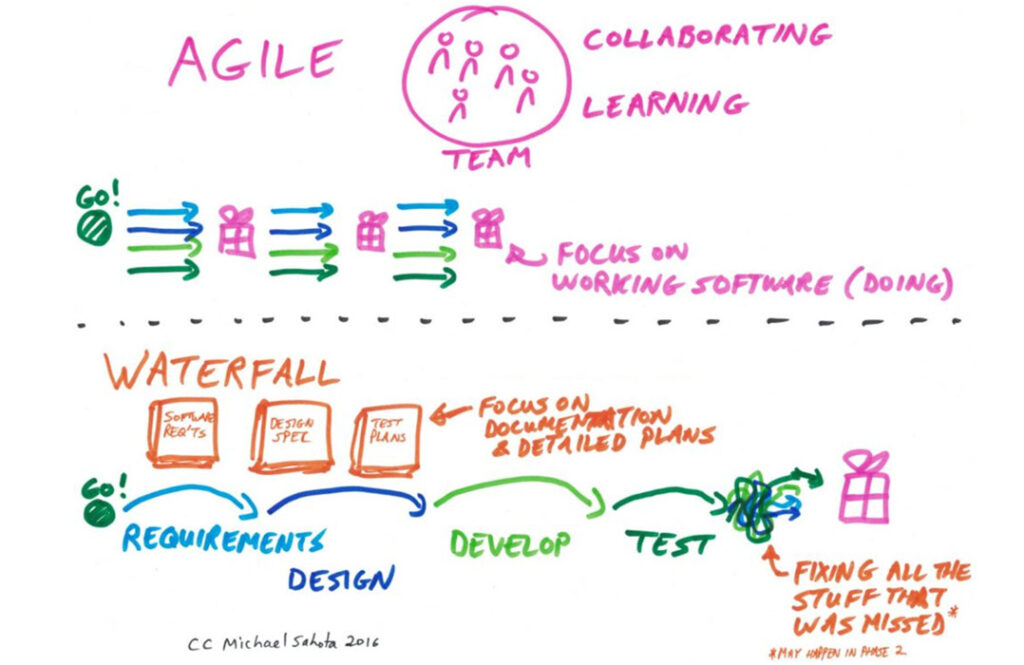
Along with many other start-ups, here at Hypercontext we prefer Agile. The method allows us to easily adapt and find the best solutions through ongoing collaboration. But which method you use will depend on the demands of your respective industry.
What are Agile meetings?
Agile meetings help facilitate continuous collaboration. When you’re managing an Agile team, daily communication and regular intervals of reflection are a must.
In fact, the original Manifesto states, “The most efficient and effective method of conveying information to and within a development team is face-to-face conversation.”
Within each sprint there are a handful of meetings that help drive collaboration, facilitate iteration and keep everything and everyone on track, including:
While that might seem like a lot of meetings for everyone to attend regularly, it ultimately ends up saving you time—especially when you’re trying to brainstorm the best solutions and iterate quickly.
Plus, these purpose-driven meetings can help you reduce the one-off meetings that would occur otherwise. You’ll be able to tackle roadblocks as they occur, prioritize work more frequently, and adapt to the changing needs of the business and its customers.
👉 Skip to the four types of Agile meetings and their agenda templates
How do you run an agile meeting virtually?
Because Agile development teams thrive with face-to-face conversation, for those who weren’t already working remotely pre-pandemic, the shift to remote work has been a challenge.
In fact, Mckinsey wrote a report on the challenging shift that agile teams faced at the beginning of 2020. Some of the greatest challenges they identified with remote agile meetings include:
- Difficulty driving complex problem solving with content-heavy whiteboarding
- Presentation issues when sharing content
- Decentralization as a barrier for dynamic communication
Despite the initial challenge, running productive Agile meetings virtually is more than possible. The key? Using the right tools. If you’re looking for the best solutions for remote Agile meetings, here are a few apps that we use to make them just as productive as in-person meetings, if not more.
Tools to help run remote Agile meetings
📹 Video calling: The phone won’t cut it. For your remote meetings, you need a video calling platform so you can communicate “face-to-face.” At Hypercontext, we use Google Meet. But you could also use one of the many other video calling tools available, such as Zoom or Teams.
📅 Meeting agenda app: Using a meeting agenda software, like Hypercontext, allows your meetings to stay focused, with a clear agenda each time. It also automatically emails the team meeting notes, so you can easily look back on what was discussed and hold everyone accountable.
(Ps. if you’re already using Hypercontext but aren’t sure how to integrate it into your agile meetings, check out our article on how to introduce the app to your team.)
📋 Project management tool: We use Linear to keep track of moving parts and track any issues. Another commonly used tool is Jira. While you don’t necessarily need this for every meeting, it’s helpful to pull up in sprint planning and backlog grooming meetings to manage tasks and keep the team aligned between meetings.
🧠 Brainstorming app: Since everyone’s no longer in the same room for brainstorming, it’s helpful to use a whiteboard app like Miro to foster more dynamic collaboration.
What are the 4 Agile meetings?
Within each sprint, there are 4 core Agile meetings that take place:
1. Sprint planning meeting agenda
The goal of the sprint planning meeting is for the Scrum Coordinator (or manager) to leave knowing who is doing what—and the team to leave understanding the work that’s required over the course of the next sprint.
Use this time to set a sprint goal for your entire team and decide what needs to get done to reach that goal.
Once you’ve identified your sprint goal and have distributed your tickets (tasks to complete), try to stick with it. Sprints are short amounts of time for a reason—they allow you to break down big puzzles into smaller pieces and focus on one thing at a time. But if you keep changing around what you’re working on within a sprint, it gets more complicated and your burn-down charts won’t look so great.
Meeting length & frequency: 60 minutes, Sprintly (bi-weekly depending on your sprint length)
Who should attend: The product owner, Scrum Coordinator (also known as Scrum Master) and the entire engineering team.
Agenda template:
- What wasn’t completed last sprint? (5-10 minutes)
- Discuss Deliverables, agree on effort and assign each ticket (40 minutes)
- Any other issues/concerns? (5-10 minutes)
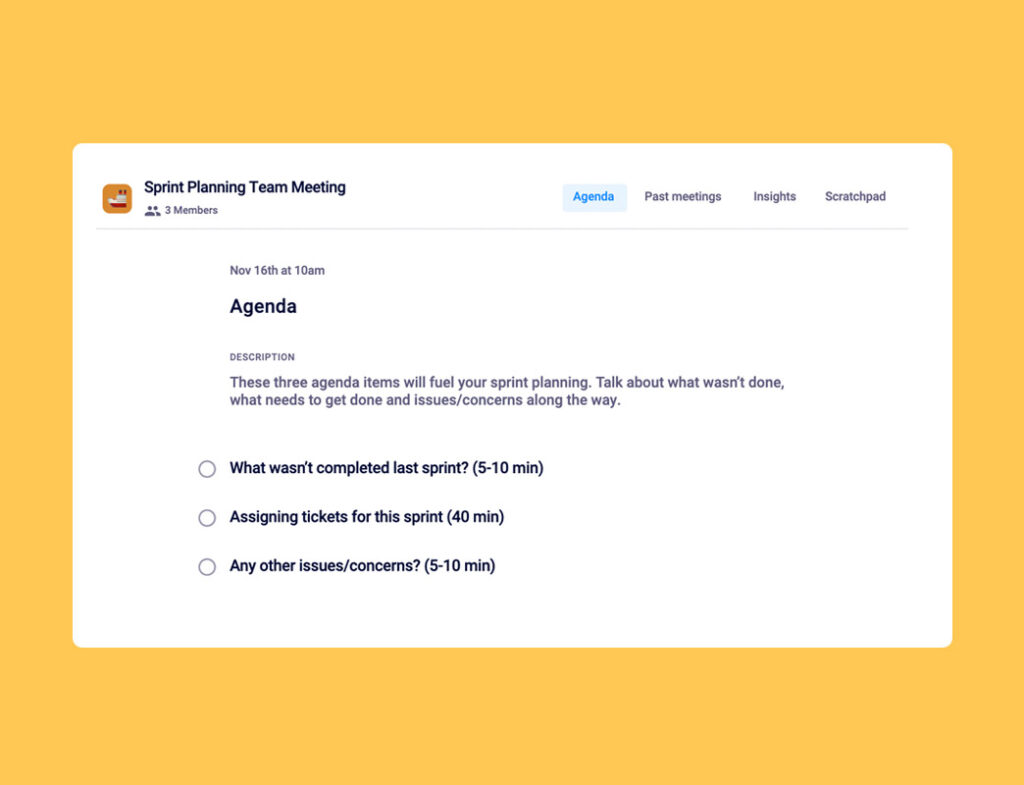
⚡️ Pro tip: When assigning tickets, make sure you communicate expectations for the work to be done. (You want to ensure that everyone understands what “done” means!)
2. Scrum meeting agenda
The purpose of the agile scrum meeting, also known as a daily standup, is to uncover blockers for the day ahead and commit to what you’re going to accomplish each day.
Ideally, you’re having these meetings each morning, and you’ll want to keep them as quick as possible. If you’re working in-office, we recommend doing them while standing up (hence the name standup). If you’re remote, you may need a bit more time, but try to stay on topic so the meeting doesn’t run too long. These are meant to kick start your day, not take it over.
If you’re new to Agile, daily meetings may seem like overkill. But, daily scrums mean that you can apply learnings faster and tackle roadblocks as they come, rather than wait a month to share why things aren’t done.
Meeting length & frequency: 10 minutes or less, daily
Who should attend: The Scrum Coordinator and the entire engineering team, product owner (optional) and any outside stakeholder as needed each day.
Agenda template:
- Blockers (2 minutes)
- What did you do yesterday? (3 minutes)
- What are your goals for today? (3 minutes)
- How close are we to hitting our sprint goals? Comfort level? (2 minutes)
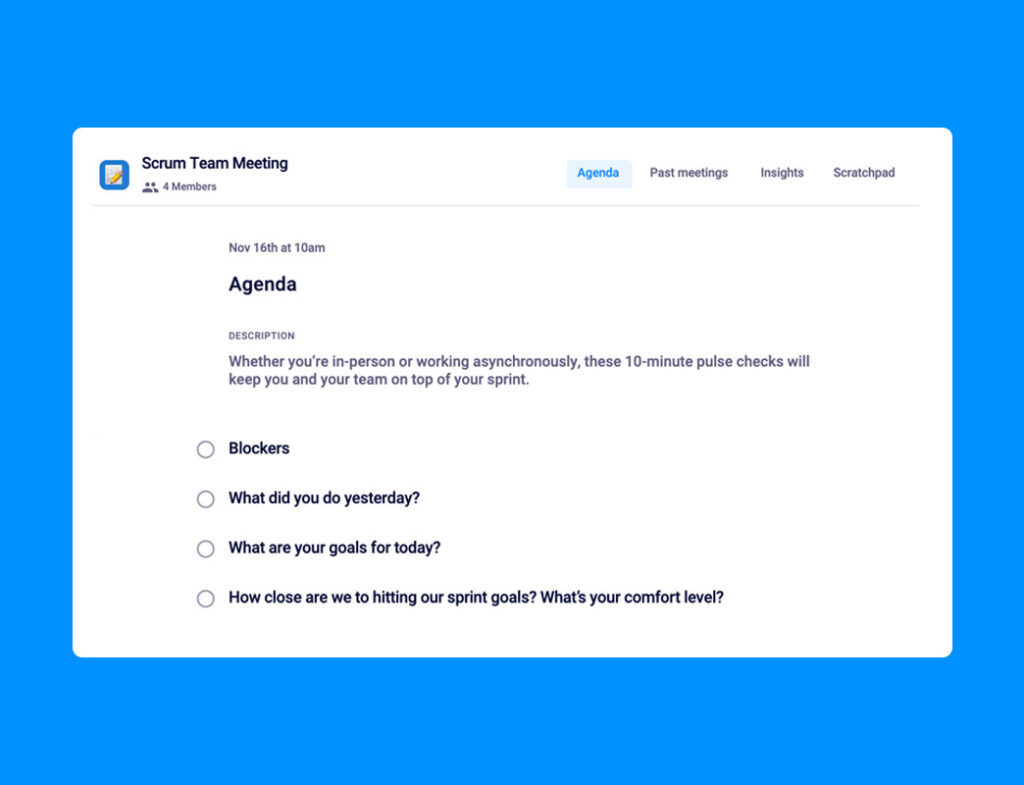
⚡️ Pro tip: If you’re part of a distributed team or prefer to hold these meetings asynchronously, decide on a time every day when people need to submit their scrum notes by. For example, perhaps at 9 am every morning the team knows to add their scrum notes for the day into your team Slack channel.
3. Backlog grooming meeting agenda
Your backlog is a list of all upcoming tasks or ideas that the team will have to tackle at some point. Backlog grooming meetings are intended to keep your backlogs up-to-date and ready to be pulled from for upcoming sprints. With changing priorities and customer needs, your backlog can get real messy and overwhelming, fast. To minimize the chaos, backlog meetings offer an opportunity to:
- Remove irrelevant tasks and ideas (I.e. when things get taken off the product roadmap)
- Prioritize what ideas are most important for when sprint planning comes around
- Clean up existing backlogged tasks and add any necessary context or requirement changes
Before deciding what needs to get done in the upcoming sprint, you need to go through the backlog of items to get done and decide which items need to be prioritized.
Meeting length & frequency: 30 minutes, Sprintly (bi-weekly)
Who should attend: The engineering team, Scrum Coordinator and product owner
Agenda template:
- What wasn’t completed last sprint that needs to be completed? (5 minutes)
- What came up that needs to be fixed? (10 minutes)
- What needs to get done to move our product forward? What’s the highest priority? (10 minutes)
- What’s something that could come down the pipeline that would disrupt everything? (5 minutes)
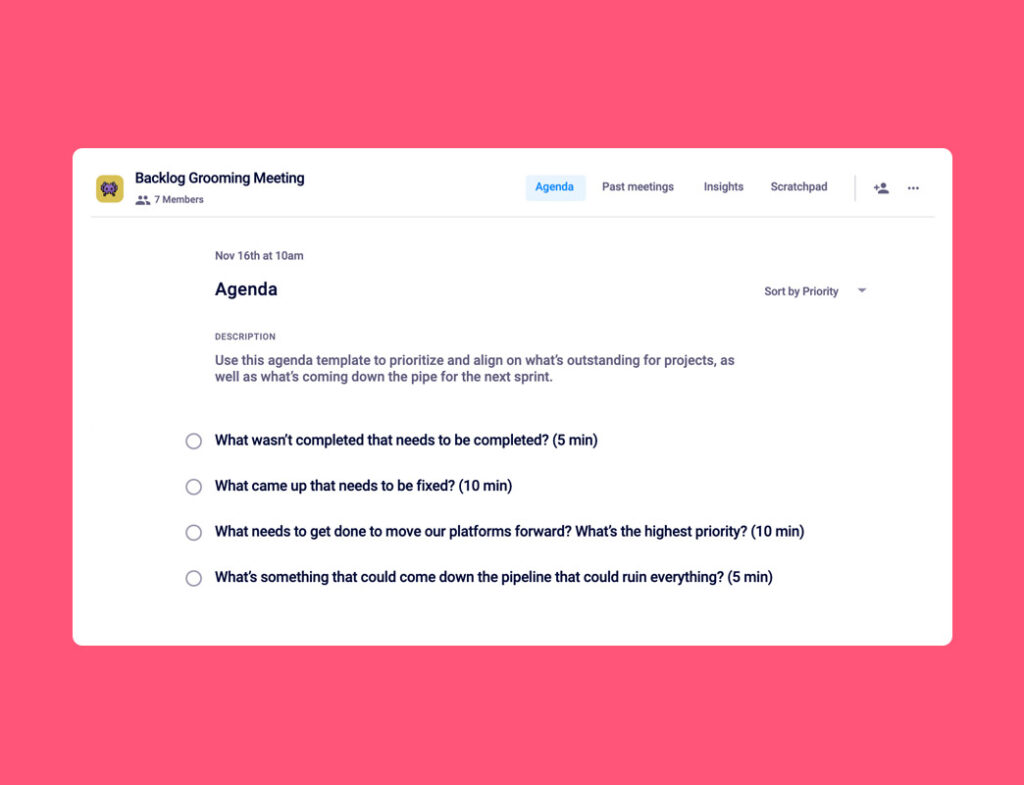
⚡️ Pro tip: Keep your project management tool, like Linear and Jira, open while you’re running this meeting. Use it to look at new bugs, issues, and technical debt to help facilitate the meeting.
4. Sprint retro meeting agenda
Your retrospective meeting is all about identifying what went well—and what didn’t—throughout the sprint and using that information to improve your next sprint. Consider things like:
- Are there ineffective processes or handoffs that could be improved?
- Are we over or under-committing with the workload we’re agreeing to each sprint?
- Have new opportunities come up that we should jump on next sprint?
An important thing to remember here is to actually follow through on your discussions. This means documenting insights and creating action items to help solve any issues that came up in your last sprint. Continue to check in and revisit issues in the future to ensure they’re being dealt with, rather than merely discussed.
Meeting length & frequency: 60 minutes, Sprintly (bi-weekly)
Who should attend: The engineering team, Scrum Coordinator and product owner (optional)
Agenda template:
- Demo (20-30 minutes)
- Product acceptance and change requests (10 minutes)
- What’s propelling us forward? What’s holding us back from achieveing our best work? What are potential obstacles on the horizon? (5-15 minutes)
- Demo day prep: Who wants to present on behalf of the Team? What do we demo? Who deserves a shout-out? (5 minutes)
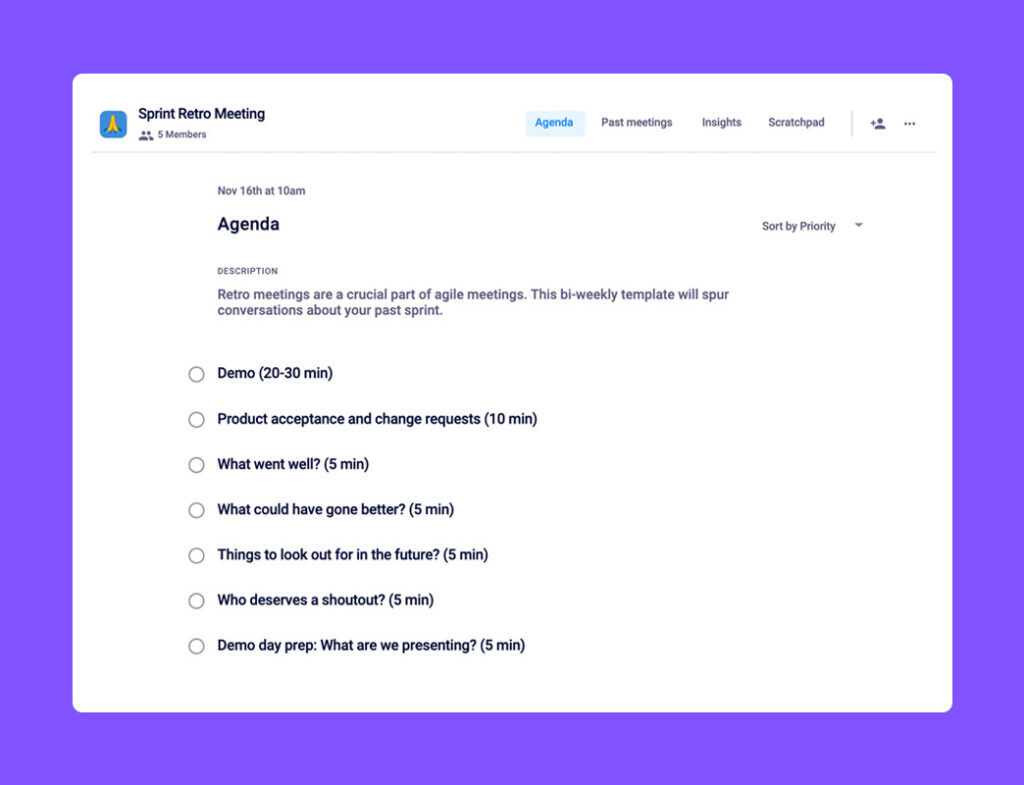
⚡️ Pro tip: Try not to let the “What’ prevented you from doing your best work?” agenda item monopolize the conversation. You can avoid this by having a place for your team to share issues and add comments asynchronously throughout the sprint, when they’re top of mind (psst…Hypercontext does that!). This keeps the conversation during the meeting quick, and focused on making decisions.
If you want to implement the Agile method on your team, start by adding these 4 meetings to your calendar. To optimize the productivity of these meetings and stay on track, try Hypercontext’s collaborative meeting agendas. ✨
What you should do now
You made it to the end of this article! Here are some things you can do now:
- We have a massive (& free) collection of meeting agenda templates all designed to help you run more effective meetings.
- Check out Spinach to see how it can help you run a high performing org.
- If you found this article helpful, please share it with others on Linkedin or X (Twitter)
